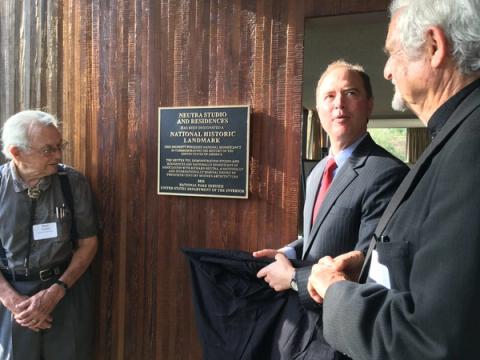In 2009, the VDL Neutra Studio and Residences were listed in the National Register of Historic Places under Criterion C at a national level of significance, and under Criteria Consideration G, as an exceptionally significant work in the context of Richard Neutra’s practice. The property was the residence and studio of Richard J. Neutra, a seminal figure in the Modern movement of architecture, along with Alvar Aalto, Le Corbusier, Walter Gropius and Mies van der Rohe. Like fellow Viennese native R.M. Schindler, Neutra introduced avant-garde European design commitments to Los Angeles in the early twentieth century. His architecture rapidly evolved under the influence of Frank Lloyd Wright and the mild southern California climate, giving primacy to the linkages between the house and its natural setting. It was at the VDL House that Neutra designed most of the works that brought him international renown. It also figures prominently in that rare but highly important set of buildings, as the studio and residence of a great architect. Analogous works are Frank Lloyd Wright’s Studio/Residence in Oak Park, Illinois and the two Taliesen facilities, as well as Henry Hobson Richardson and Frederick Law Olmsted’s studio residences in Brookline, Massachusetts.
The significance of the property has been recognized by the City of Los Angeles with its designation as Los Angeles Cultural Monument Number 640. It was also the subject of a Preserve L.A. Grant, awarded by the Getty Foundation in 2002. Since 2008, Cal Poly Pomona and the Friends of the Neutra Research Site have raised more than $350,000 to assure a safe electrical system and repair leaking roofs. In 2009, it was included in the National Registry of Historic Places at the national level of significance.
In 2017 the Neutra compound was awarded designation as a National Historic Landmark under Criterion 2, for its association with the productive period of a person of national historic significance and because it is the best place to interpret and explain his career. In the summary of the nomination letter the importance of the house was described thus:
«The Neutra VDL Studio and Residences have an important association with the productive life of architect Richard Joseph Neutra (1892-1970). The compound, built with a loan from Dutch industrialist van der Leeuw (VDL), is important with regard to his life not only because he lived there, designed most of his 300 projects there and his ashes are buried there, but also because he consciously used the compound to demonstrate the full range of his architectural commitments to prospective clients and a wide public.
The Neutra VDL Studio and Residences also offer the best opportunity for interpreting his national historic contributions because it is open to the public and it responds to the design challenge that most interested Neutra: how to create a humane indoor-outdoor, multi-household environment on a small urban space with a small budget, a challenge not offered by some of the more opulent and famous projects. It is the only location where one can see in one place the evolution of a practice spanning nearly half a century. One sees what Neutra alone in 1932 and 1940 and what Neutra with his partner and son Dion in 1966 had been trying to demonstrate and publish, all along, for wider application for all those challenged and inspired by the twin constraints of a small footprint and a small budget.»
The Landmark nomination was prepared by Dr. Raymond Richard Neutra MD, PH, based on National Registration by Lauren Weiss Bricker and with assistance from Christine Madrid French, Barbara Lamprecht, Theo Prudon, Pierluigi Serraino, John Crosse and Sarah Sheridan.
